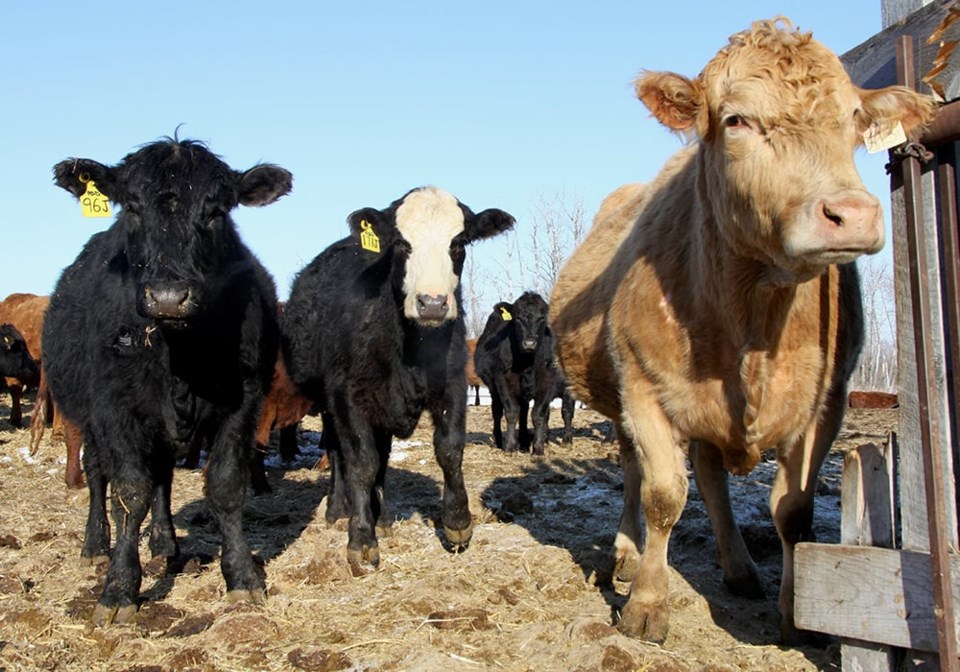MARTENSVILLE — A 48-year-old man faces criminal charges after Saskatchewan and Alberta RCMP recovered 10 head of cattle that were stolen in Thorhild, Alta., and taken to a pasture near Martensville, Sask.
The recovered cattle are worth more than $25,000.
In February, the Alberta RCMP Livestock Investigations Unit launched an investigation after 30 cattle were reported missing from a herd in Thorhild. Initial investigations indicated the cattle may have been moved out of the province.
Based on preliminary information, investigators believed the cattle were destined for Martensville, RCMP said in a media release.
RCMP livestock investigators from Alberta and Saskatchewan, including members from the Martensville detachment and Livestock Services of Saskatchewan, executed a search warrant at properties in the Rural Municipality of Corman Park on March 16.
“We were asked to check some local properties for these particular cows with that particular brand,” said Cpl. Owen Third, Saskatchewan RCMP’s livestock investigator.
Ten of the missing cattle were identified and seized based on registered Alberta livestock brands. They were in a pasture with other livestock.
“There were other cattle that were close or met that description, but didn’t carry the same brand tag, or the same markings that we were looking for,” said Third.
The cattle, 20 of which are still missing, are described as black white-face or black brockle-face animals bearing brands BAR 2 V on the right hip and/or 6 over split end bar on the left hip.
After executing the warrant, the seized cattle were taken to Saskatoon Livestock Sales where brand inspectors could make a thorough inspection.
“They had to clip them and make sure that the brand that we were looking for was actually on those cattle. That’s why only 10 were at the end seized,” said Third.
A man was arrested without incident and charged with possession of property obtained by crime over $5,000. He was released and is scheduled to appear in Saskatoon provincial court on May 16.
“It was a four-way joint effort, beginning with Livestock Identification Services and the RCMP in Alberta and then moving over to Livestock Services of Saskatchewan and the RCMP in Saskatchewan,” said Garth Woods, manager of operations at LSS.
If the cattle had not been branded or documented, the matter might well have gone another way, said Woods.
“It typically would be a ‘he said, she said’ thing that would end up in a civil suit or maybe just end up as a lose-lose deal that everybody walks away from,” he said.
“Having an inspector recognizing and finding animals on that property that are a part of the complaint and then being able to work together with two sets of RCMP divisions and two inspection agencies is pretty satisfying for us and our industry. I think it’s a win-win.”
Registered livestock brands are the primary means of ownership identification on cattle and horses.
“The protection provided by the brand, really nothing matches it. Regardless of how convoluted processes might get, the brand is really the one thing that still stands the test of time as a prima facie proof of ownership,” Woods added.
“We recommend, based on what we see as failures lots of times, is that people who brand and people who adhere to having inspection documents, which is a third-party record of what moved where, it virtually always serves them well when trouble rears its head.”
However, proof of identification is different from proof of ownership.
“A tattoo on an animal’s ear is only proof that (it) is that animal. It may belong to anybody. There may be records that support who actually owns it, but nothing proves whose animal that is, immediately in a prima facie way, that a brand does,” Woods said.
Suspected livestock theft is different from fraud, which tends to involve credit or civil matters.
“There’s usually some background stories, and that’s what makes it an interesting twist in a lot of files, is that there quite often is some civil relationship between the people that end up on opposite sides of a criminal complaint,” he said.
“They maybe had an agreement that was gone back on or poorly executed. Not many things equal the livestock industry in that respect.”
Harbouring is the most common occurrence in the livestock industry that involves small numbers of missing animals.
“That’s the act of keeping something. You didn’t go and steal it, but it got in with your cows and you kept it. As far as the number of files, that’s the most common criminal finding,” said Woods.
If livestock are missing, producers should first call their provincial livestock services branch, which will flag and share the information interprovincially.
Reports of irregularities are forwarded to the RCMP and in some cases an investigation will occur. However, missing or stolen cattle are seldom located, noted Third.
“Not very often do I get a call from LSS saying, ‘we located one or two of these heifers or steers with this particular brand.’ It does happen but not very often.…
“The numbers are fluid and the people involved are somewhat fluid, but everybody puts a lot of effort into making things work well because it’s not in a caretaker or a customer’s best interests if (an) animal’s missing in the long run.”
Anyone with information on the location of the 20 missing cattle can contact RCMP Livestock Investigations at 403-598-6991 (Alberta) or 306-537-9448 (Saskatchewan), or Crime Stoppers at 800-222-8477.
Contact [email protected]

